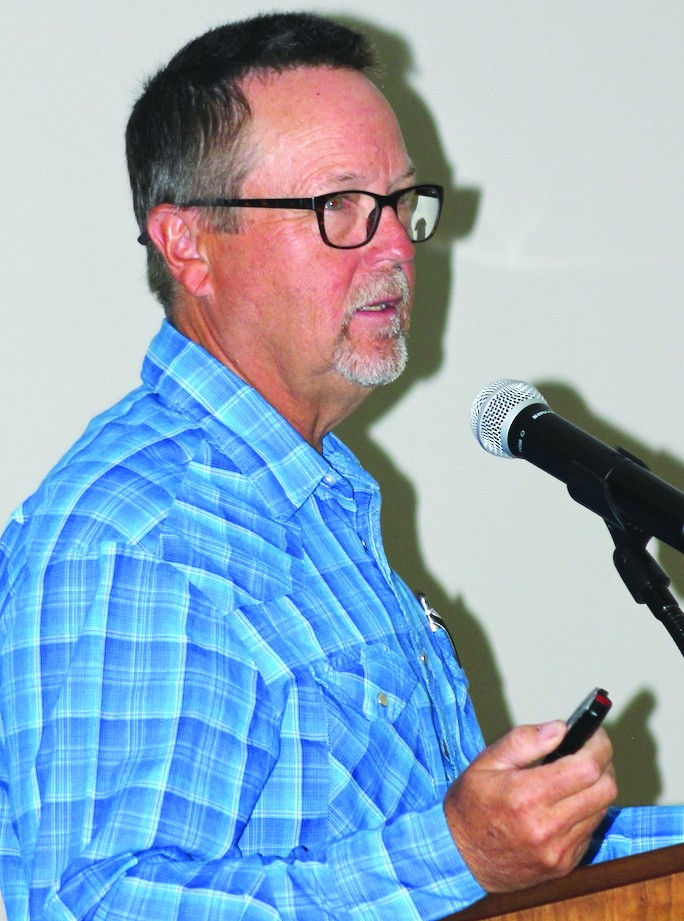Gold rush’ of CBD production driving more hemp acreage

Driving increased hemp acreage among the topics at third economic summit
ALAMOSA– “They say it grows like a weed,” chuckled Monte Robertson, founder and general partner of SLV Hemp Company, in his presentation to about 100 attending the third annual SLV Economic Summit at Adams State University.
That very statement and the fact that acres in hemp production in Colorado and the San Luis Valley has nearly doubled or more every year since 2014 leaves Robertson with concerns that the “gold rush” over CBD oil from hemp will lead to overproduction. He reminded attendees that hemp should not be confused with marijuana and its slang name “weed.”
Monday’s conference was hosted by Adams State and Trinidad State Junior College whose respective presidents, Dr. Cheryl D. Lovell and Dr. Rhonda M. Epper, who gave welcoming comments.
Robertson’s hemp presentation opened the session that featured local and state economic development leaders and a keynote speech from Stephan Weiler, professor of economics at Colorado State University. Also featured were representatives of the Colorado Office of Economic Development and International Trade (OEDIT) and Downtown Colorado, Inc.
Capping the daylong event was a panel discussion on regional business expansion, retention and innovation moderated by Tom Monaco, director of the SLV Small Business Development Center (SBDC). Featured on the panel were Courtney Logan, Monte Vista, of Lucky Shoe Creations and Riding Club, LLC, Randy and Micah Jackson of Rustic Log Furniture, Alamosa, and Ed and Dana Sowards of Hometown Foods, Antonito.
Just to entice summit goers just before lunch, a trio presented on “San Luis Valley Food to Table.” Presenters included Liza Marron of the SLV Local Foods Coalition, Wes O’Rourke of Sol Mountain Farm and Nick Chambers of the Valley Roots Food Hub.
A nearly five-year veteran of the hemp industry in the valley, Robertson said the Colorado Department of Agriculture (CDA) reports a 200 percent growth in nine months for the number of registered hemp growers in the state at about 2,600. That compared to just 131 registrants for 1,800 acres in 2014 which had grown to 835 registrants with 30,950 acres in 2018.
Robertson said some reports are that there may be over 20,000 acres under productions this year in the San Luis Valley alone, but he conservatively puts that number closer to 11,000 acres. Five of the six SLV counties have hemp registrants, led by Saguache County with 36 registrants and 61 licenses to grow.
While almost all SLV hemp producers contacted by Robertson, said they are growing for CBD production, he feels the real future for the crop is in food and fiber. Hemp seed, he explained, is truly a “super food” with all nine essential amino acids.
Hemp has been used for food and fiber for 10,000 years, according to Robertson, with canvas made from hemp used for boat sails that brought people to the new world 600 years ago. He also noted that the U.S. Constitution was drafted on hemp paper.
Robertson said hemp has already had a substantial economic impact on the SLV as proven in banking statistics growing to millions of dollars on deposit in 2019. His conservative estimates are that jobs on farms have grown to more than 344 with hemp, paying $12.50 to $40 per hour, and an additional 33 people in processing jobs and another 20 in manufacturing.
Power Zone Equipment, through its new company, Formation Ag, is manufacturing hemp harvesting equipment that is being shipped all over the world, including a recent shipment to Lithuania. With three hemp processing operations currently operating in the valley, Robertson estimates up to five more coming on-line here this year, most of which will be harvesting CBD.
More jobs are created through support services, he noted, including automotive, construction, irrigation equipment, fertilizer, custom harvesters, storage space and even food services as farmers feed their employees.
In addition, the fact that hemp is estimated to use about one-half the water it takes to grow potatoes and one-third the amount needed for alfalfa, farmers are seeing considerable savings in utilities to pump and deliver irrigation, not to mention reducing water usage in the SLV.
Hemp is also a perfect rotational crop for potatoes, alfalfa and other crops because it is a “cash crop” unlike many others used for rotation.
Robertson said the hemp industry in SLV is “alive and well” and added that Adams State has been a valuable partner in assisting with marketing and business development for the hemp industry. Education is a top priority, he said, adding, “We must teach the teachers.”
He has done his part by telling the hemp story over and over, including through national farm publications.



